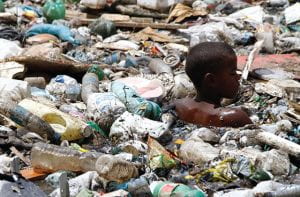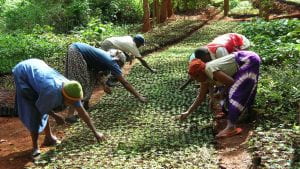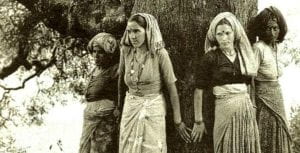There is a definitive link between the oppression of women and the oppression of nature which is shown all around the globe in different ways.
Ivone Gebara, a “liberation theologist” and author of Ecofeminism: A Latin American Perspective, discusses ecofeminism in a new way. Gebara believes that in order to understand the different trials and tribulations that occur in someone’s daily life and how to understand or solve them, we have to first reflect on which type of daily life we are looking at. Wherever someone resides in the world, there are a multitude of caveats that come along with it. For example, solutions for marginalized women who suffer daily under a patriarchal society and a “capitalist dominion of nature” would differ for someone from a middle-class family living in the United States (Gebara 95). Gebara compares daily life for poor women to being in jail due to the patriarchal, capitalist system (Gebara 95). Women are seen as providers, providers of food, a clean-living environment, healers for loved ones (Gebara 95). These marginalized women are aware of their difficulties they inevitably face in life however they “have no real means to search for and experiment with new alternatives” (Gebara 95). When young women are becoming pregnant in their early teenage years, this limits their life choices as well as educational advancements (Gebara 95). It is a continuous cycle that helps to create both poverty and inconstancy (Gebara 96). Within the patriarchal structure there is no equality, no egalitarian social structure to help overcome poverty, environmental problems, social inequalities and the oppression of women (Gebara 96).
In Recife, Brazil people who are living along a canal are being subjected to immense amounts of garbage (Gebara 96). Instead of helping to take the garbage out of the canal, more trash is added while the canal waits to be cleaned by workers sent by city officials, however to no avail since the canal becomes littered once again the next day (Gebara 96). A ten-year-old child named Larissa Silva who lives in a cardboard house with her family asked the interviewer, Talia Correa, to answer the question “Do you think I like living here?” Correa responded with no, however Larissa stated “But I do. It’s the only life I know” (Correa 2014). In Recife, there was a photo of a child, who was only nine-years old, trying to find cans to sell by wading and swimming in the canal filled with garbage (Correa 2014). There are thousands of children that are living in slums in neighborhoods in Recife (Correa 2014). After the photo of the child, named Paulo, was gaining traction and was put in the press, then both international authorities and the local government took action, the government helping Paulo’s family by placing him and his family on welfare (Correa 2014). However, this doesn’t help the thousands of other children and families who collect aluminum to sell for money to provide for their families and are subjected to bathing and playing in garbage filled rivers (Correa).

“You can help some people, but you can’t change a hierarchical structure that reproduces unfair solutions” -Ivone Gebara
There are also links to violence towards the land and violence towards indigenous women (Gendered Impacts 2015). During environmental assessments, the question of who is going to be impacted and how, is not asked, there is only a statement that money and jobs will be abundant (Gendered Impacts 2015). When the Baker Lake in Canada was subjected to environmental degradation from mining, the Inuit women who rely on the land for a multitude of ways were also subjected to an increase in violence at home, at the mining site as well as in the community (Gendered Impacts 2015). Indigenous women have a deep relationship to the land, as it sources their identity and song (Gendered Impacts 2015). By mining the Inuit’s land, it not only caused important animals to change their migration routes but was a deep violation of the women’s livelihood and created a loss of cultural practice and traditional knowledge (Gendered Impacts 2015).
It can be stated that female poverty and the destruction of ecosystems are linked. In many parts of the world, Africa included, women solely hold the responsibility of caring for the harvest which includes tilling fields, picking out the produce to plant and making sure the crops are cared for (Maathai 2000). Since women are the nurturers and caretakers of the plants, looking after the children and fetching the water, if there is environmental damage, a dry well or agricultural contamination from pollution, pesticides or herbicides, then they are the first to notice any abnormalities (Maathai 2000). Back in 1977, environmentalist and women’s right activist from Kenya, Wangari Maathai, became the founder of the Green Belt Movement (Maathai 2000). This movement helped encourage farmers, who are mostly women, “to plant “Green Belts” to stop soil erosion, provide shade, and create a source of lumber and firewood” (Maathai 2000). Since then, over fifteen million trees have been planted as well as creating income for eighty thousand people (Maathai 2000). The Green Belt Movement was created because women were being affected by environmental degradation in both rural and urban areas (Maathai 2000). There was no firewood or fruit to help children that were malnourished, drinking water had been contaminated due to pollution, pesticides and herbicides used to grow “cash crops” and women and their families became weak, unable to fight off diseases due to the impoverishment from the degraded environment (Maathai 2000). Within the Green Belt Movement came influence for neighbors to start planting trees on their farms which ultimately drew so much attention that parliament and the president said the environment needs to be protected (Maathai 2000). What started with women empowerment resulted in forests being saved from environmental degradation, and spaces and forests not being privatized or used for economic gain (Maathai 2000).

“Environmental protection is not just about talking. It is also about taking action.” – Wangari Maathai
Like the Green Belt Movement in 1977 in Kenya, Africa, in India in the 1970’s another movement was on the rise, known as the Chipko movement which involved villagers embracing trees so that they would not be felled by contractors’ (The Chipko Movement). Ultimately thousands of trees were saved from being felled due to village women hugging the trees (The Chipko Movement). This movement paved the way for future successes. In the 1980s, Chipko protestors were able to help achieve a fifteen-year ban in the Himalayan forests for felling (The Chipko Movement). After this movement, felling in other states in the country ceased and it “generated pressure for a natural resource policy that is more sensitive to people’s needs and ecological requirements” (The Chipko Movement).

These movements could not have been as successful as they were without first empowering women. Ordinary people have the power to make a difference, put pressure where pressure is needed, and create change. There are all different types of misinformation that can be obtained through the internet or by dictatorial government ideology such as in Kenya after the Cold War when information was strictly controlled, and people became oppressed and full of fear (Maathai 2000). The people who live in the forests and along rivers are the ones who are living through environmental degradation and therefore should be the ones that share their stories, speak out, and highlight the true narrative, the root of the problem, on a local as well as national level.
Works Cited:
Correa, Talita. “The Brazilian Slum Children Who Are Literally Swimming in Garbage.” VICE, 30 Jan. 2014, https://www.vice.com/en/article/kwpwja/the-brazilian-slum-children-who-are-literally-swimming-in-garbage-0000197-v21n1.
Gebara, Ivone. “Ecofeminism: A Latin American Perspective.” Crosscurrents. 2003. 95-102.
Maathai, Wangari. “Speak Truth to Power.” The Green Belt Movement, 4 May 2000, http://www.greenbeltmovement.org/wangari-maathai/key-speeches-and-articles/speak-truth-to-power.
“The Chipko Movement.” EduGreen, Teri, 2007, http://edugreen.teri.res.in/explore/forestry/chipko.htm.
“2015 Gendered Impacts series (4): Land is Identity (2:28).” YouTube, KAIROS Canada, 14, March 2016. https://www.youtube.com/watch?v=LopcPrSvDBw
“2015 Gendered Impacts series (5): Violence Against The Land (3:02).” YouTube, KAIROS Canada, 21, March 2016. https://www.youtube.com/watch?v=Mlbc2dD0gP0&t=28s

Hi Sam!
I really enjoyed reading your post. I really like how you jumped around from culture to culture giving a really inclusive global picture of ecofeminist activism and connectivity between oppression of land and oppression of women. The VICE article “The Brazilian Slum Children Who Are Literally Swimming in Garbage” by Talita Corrêa is a powerful work detailing the lengths that people have to go to to survive and the conditions they live in Recife, Brazil. You touched on this issue, but I found it staggering that it wasn’t until news coverage picked up photos of the children that something was done to rectify this situation. Brazilian government, authorities, and social workers knew the depth and gravity of these issues, but it is not until the issue is brought before the court of public opinion is something done. I really appreciated your commentary throughout your post and I look forward to reading more!!
Elizabethe Schlumbohm